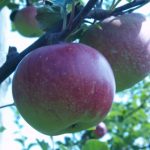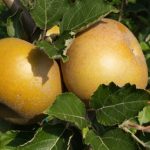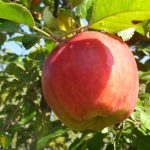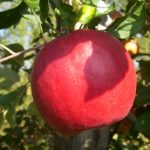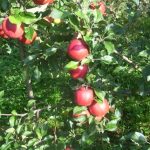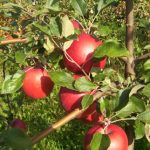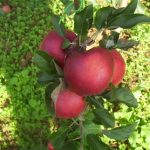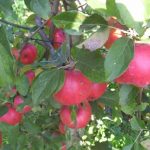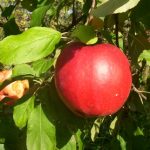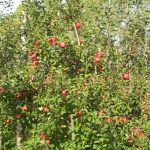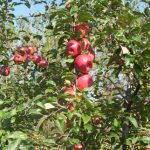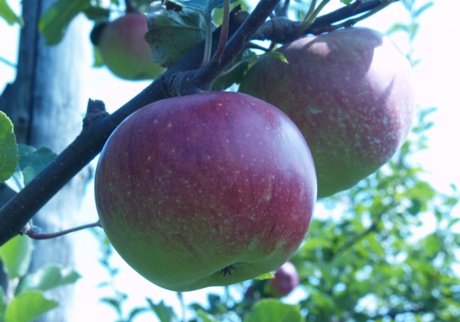
Seal of quality
Prodotto Agroalimentare Tradizionale (PAT) / Typical food-farming product.
Description
The category includes some old apple varieties once grown abundantly, especially in the Cuneese and then almost completely abandoned after the war in favour of new cultivars of American origin such as Golden and Red Delicious.
These are rustic varieties, often resistant to certain adversities, but which, because of their being native of these areas, have adapted to the climatic cultivation conditions. They adapt perfectly well, therefore, to methods of cultivation with low environmental impacts and in particular to organic farming methods.
There is still a noticeable production of certain varieties, or varieties that could be recovered and newly cultivated, such as Buras, Carla, Contessa, Gambafina lunga and Gambafina piatta, Ravè verde ad Runsè.
Buras
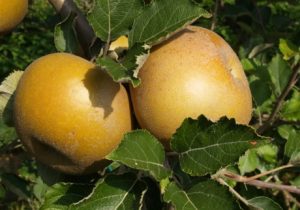
The origin of this variety is a mother tree found in Valle Maira. It is a rustic variety, tolerating scab, sensitive to virescence and to bitter pockmarking. It is productive but subject to change. It is suitable for long-term storing: the fruit tends to shrivel but does not become “floury”, therefore it maintains good flavour. It is also suitable for cooking.
The fruit has a short asymmetrical conical trunk shape, with a ribbed or circular transversal profile; the peduncle is short and is medium-large. The peel is slightly rough and wrinkly (it can reach 100% of this aspect) and presents average and wrinkly lenticels. Its basic colour is green-yellow with no overcolour, It is of medium size, green-white pulp, course texture, crunchy and has an acidulous-sweet flavour.
Carla
This variety has its origin from a mother tree found in Barge. It is characterised by excellent fertility and good productivity; however, accurate pruning is required. It is particularly suitable to be eaten raw, provided it is eaten by the end of the month after harvest, as it does not store very well.
The fruit is of an asymmetrical conical trunk shape, with an irregular transversal profile. The peduncle is medium-long and is of a medium-large size. The peel is smooth, not wrinkly, it presents small and aureo lenticels. Its basic colour is green-yellow with some hints of orange-red. The pulp is a cream white, its texture is delicate, fondant-type, sweet and the apple is medium-small in size.
Contessa
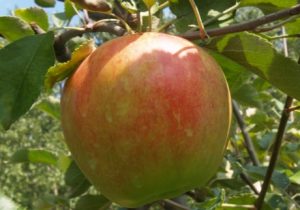
This variety originates from a mother tree found in Valle Maira. It is one of the average productivity varieties and is subject to alternation, it is particularly sensitive to bitter pockmarking, it is suitable to be eaten raw and is not very storable.
It is a big fruit and its shape is symmetrical, spheroidal or flat. The stalk is short, medium-large with a wrinkly aspect at peduncle cavity level; the basic colour is green-yellow and overcolour a soft red. The pulp is of a creamy white colour, it is a sweet apple with a delicate texture, of the crunchy type.
Gambafina
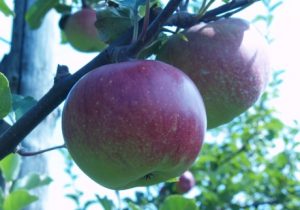
The origin of the Gamba Fina lunga is unknown, but, according to Breviglieri, it dates back to the end of the 19 th century from a variety cultivated in the Caraglio area. There are two different types (long and flat), according to the length of the peduncle; the mother tree of the Gamba Fina Piatta has been found in the village Famolosa in the commune of Bibiana.
It is a variety with good yield and produces fruits suitable for fresh consumption, and is generally storable. The size of the fruit is medium-small, of a symmetric spheroidal shape; its peel is smooth and a little wrinkly at the peduncle cavity level. Its basic colour is yellow green, overcolour a; its pulp is a streaky red; its pulp is white with shades of pink close to the peel, and is of a fondant type, it has a delicate texture and a sweet flavour.
Ravè verde
A productive cultivar, barely sensitive to oidium and scab, but tends to have a vitreous aspect; it is suitable for storing even for medium-long periods.
The fruit is medium-large in size, with an asymmetrical shape with a ribbed transversal profile, the peduncle is short and large, the peel is smooth, not wrinkly, and presents medium and aureo lenticels. Its basic colour is green with shades of orange. It has a creamy white pulp.
Runsè
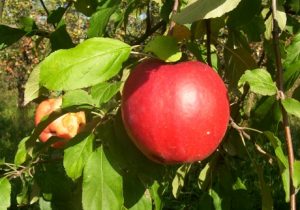
This variety takes its origin from a mother tree found in the commune of Cavour. Its yield is good, although it is subject to alternation; it is particularly suitable to be eaten raw and stores very well.
The fruit is of medium size, it is of a short symmetrical, conical trunk shape with a ribbed transversal profile, its peduncle is long and thin, the peel is smooth, not wrinkly; it has medium and aureole lenticels of a yellow-green colour and bright red or vinous overcolour. It has been noticed that in the storing period, the colours of the fruits are generally less bright and this phenomenon is more noticeable in fruits stored in special fruit-storing places. The pulp is a cream white colour with shades of pink close to the peel, it is juicy, its texture is delicate and its flavour is aromatic-acidulous.
Nutritional characteristics
The apple is the dietary supplement par excellence, thanks to its high and balanced composition of vitamins and mineral salts. Its high content of polyphenols, antioxidant agents that defend the organism against free radicals, help to slow down cell ageing and the setting in of various diseases such as those related to the cardiovascular system, and neoplasm formation.
| FOOD | Mele fresche con buccia | Mele fresche senza buccia | |
|---|---|---|---|
| Edible part | % | 85 | 79 |
| Water | g | 85,2 | 82,5 |
| Protein | g | 0,2 | 0,3 |
| Fat | g | tr | 0,1 |
| Carbohydrates | g | 10 | 13,7 |
| Starch | g | 0 | tr |
| Soluble sugar | g | 10 | 13,7 |
| Total fibre | g | 2,6 | 2 |
| Energy | kcal | 38 | 53 |
| Kilojoules | kJ | 161 | 224 |
| Sodium | mg | 2 | |
| Potassium | mg | 125 | |
| Iron | mg | 0,3 | |
| Calcium | mg | 7 | |
| Phosphor | mg | 12 | |
| Thiamine | mg | 0,02 | |
| Riboflavin | mg | 0,02 | |
| Niacin | mg | 0,3 | |
| Vit A ret. eq. | mcg | 8 | |
| Vit C | mg | 6 | |
| Vit E | mg |
Area of production
The production area includes the entire region of the mountain valleys of the Province of Cuneo.
History
Apple growing in Piedmont is an ancient tradition that goes back to the mists of time. Many apple varieties were even imported to this region as long ago as the Roman times.
It was in 1700, when farmers crossing the Alps in search of work began to import new seeds, varieties, implantation and pruning systems already present in France, that Piedmontese fruit growing first appeared on the scene. At the beginning of the 20 th century, the apple-growing area
mainly involved the Alpine valleys and Piedmont areas and hills, though it was beginning to extend to the highlands of Cuneo . The productive nature of this region is confirmed by the vast range of local varieties that arise from here. Thanks to the approval of consumers and to the vicinity of markets, such a range of varieties has maintained its strength to such an extent that modern varieties have emerged, with which it is possible to satisfy more extensive markets and, what is more, markets further away. At this point, local varieties risked disappearing and cultivation remained limited to certain marginal areas, above all mountain areas, from where, today, these varieties are slowly being recovered.

